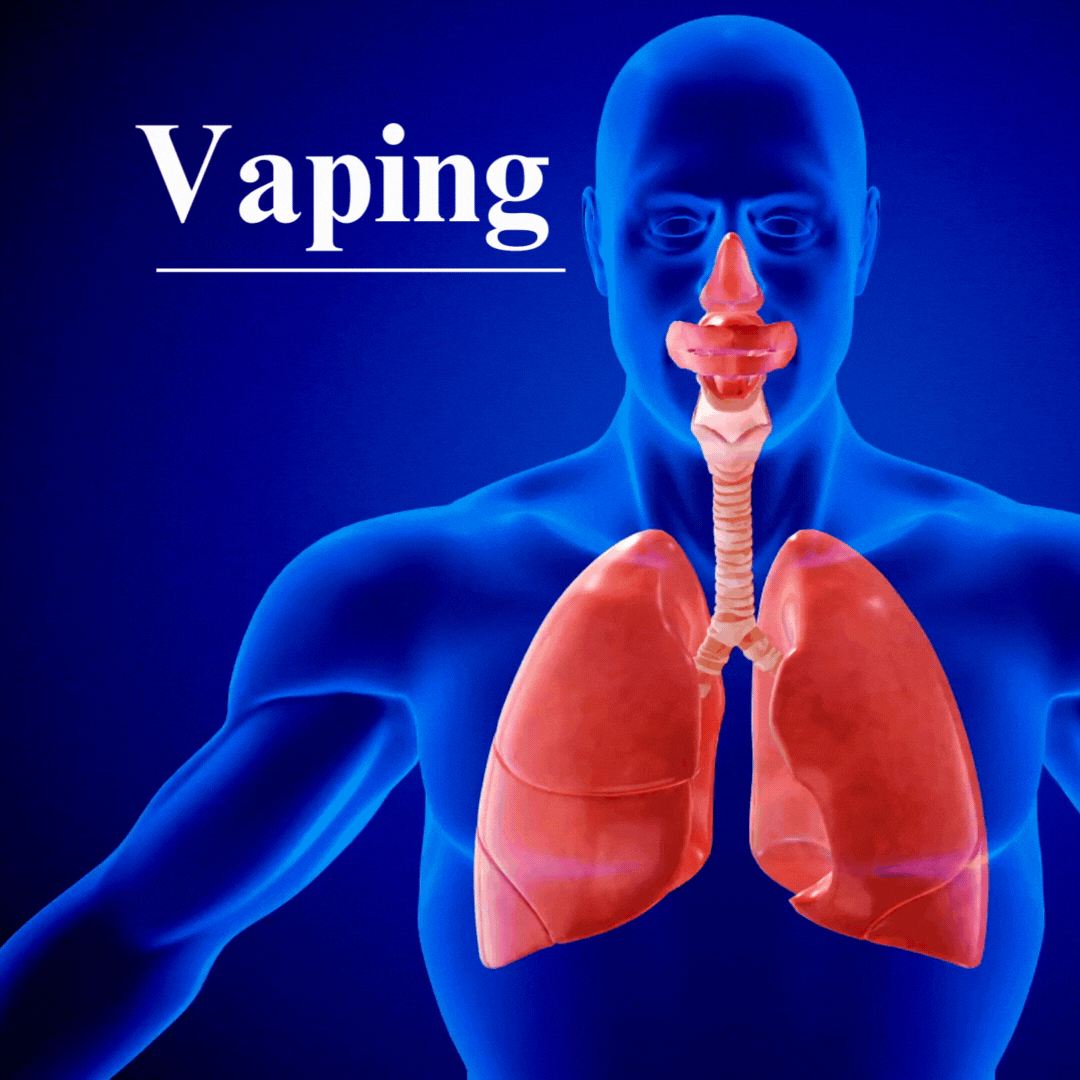Introduction:
The rising popularity of electronic cigarettes, commonly referred to as vapes, is evident, especially among the younger demographic. However, it’s crucial to recognise that e-cigarettes are not without risks, as they can lead to adverse health effects and harm the lungs.
Vapes: A cocktail of chemicals
The majority of e-cigarettes available in Australia contain nicotine, even if their packaging suggests otherwise[1]. Nicotine, a highly addictive and toxic substance, has the potential to harm brain development and affect attention, learning, memory, and mood. Additionally, all e-cigarettes, irrespective of their nicotine content, may include hazardous substances in both liquids and aerosols[2]. A recent study conducted by Curtin University researchers assessed the chemicals and toxicity of 52 flavoured e-liquids available over the counter in Australia. The findings revealed a complex mixture of chemicals, raising significant concerns about the safety of these products[3]. These substances comprise well-known carcinogens such as:
- formaldehyde (commonly used in industrial glues and for preserving corpses),
- acetone (found in nail polish remover),
- acetaldehyde (used in chemicals, perfumes, and plastics),
- acrolein (a component of weedkiller),
- and heavy metals like nickel, tin, and lead.
Other components found in e-cigarettes include:
- propylene glycol (a solvent in fog/smoke machines),
- polyester compounds,
- anti-freeze (used in car coolant), and
- vegetable glycerin (a liquid derived from vegetable fat)[4].

Source: https://lungfoundation.com.au/lung-health/protecting-your-lungs/e-cigarettes-and-vaping/
Introducing nicotine to a new, younger market
According to data from the Australian Bureau of Statistics, more than 1 in 5 (21.7%) young Australians aged 18-24 and 7.6% of 15–17-year-olds have used an e-cigarette or vaping device, although these figures may be underreported as responses were provided by adults in the same household.
Health Risks and Harms of Vaping:
The health risks tied to vaping transcend nicotine addiction. A review by the Australian National University emphasises many adverse effects, encompassing:
- poisoning,
- acute nicotine toxicity leading to seizures,
- burns,
- lung injury, and
- heightened respiratory symptoms.
- Furthermore, vaping is linked to an increased propensity to initiate cigarette smoking, functioning as a gateway to further health complications[5].
Vaping and Lung Disease:
The correlation between vaping and lung disease raises significant concerns, with over 2807 reported cases in 2020, including 60 fatalities[6]. While vitamin E acetate in e-cigarettes was identified as a likely cause, the involvement of other unidentified constituents remains a possibility. Both human and animal studies indicate adverse effects on lung function, inflammation, and the potential development of chronic respiratory diseases.
Regulatory Reforms and TGA Guidelines:
Responding to the public health challenges posed by vaping, the Australian government implemented reforms effective January 1, 2024[7]. These include a ban on importing disposable vapes without a valid license, heightened quality standards for therapeutic vapes, and the cessation of the Personal Importation Scheme for vapes. The Therapeutic Goods Administration (TGA) underscores the significance of consulting healthcare professionals for smoking cessation or nicotine dependence management, highlighting potential risks associated with unregistered therapeutic vapes.
Vapes on prescription. Nicotine Addiction and Smoking Cessation:
While there is contention over the prescription of nicotine e-cigarettes by doctors as a smoking cessation method, the evidence supporting its efficacy remains limited. Nicotine e-cigarettes may be prescribed as a last resort when conventional strategies prove ineffective. Recent reforms implemented by the Australian government, effective from January 1, 2024, aim to curtail access to nicotine e-cigarettes among adolescents and young adults, acknowledging the potential harms associated with their use.
As of the newly released guidelines by the Royal Australian College of General Practitioners (RACGP), physicians are now empowered to prescribe nicotine vapes when traditional smoking cessation methods prove ineffective for a patient.
Conclusion:
In navigating the evolving landscape of smoking cessation, individuals aiming to quit smoking or use of vapes are advised to explore evidence-based methods supported by reputable healthcare professionals. The intricate relationship between smoking and vaping and their impact on health necessitates informed decision-making. Establishing a robust relationship with your GP becomes pivotal in this journey toward a smoke-free and healthier life. Through personalised guidance, individuals can make informed choices, ensuring their path to quitting is not only effective but also safe, contributing to long-term well-being.

[1] DepHAC. 2024. About vaping and e-cigarettes. Australian Government. Department of Health and Aged Care. https://www.health.gov.au/topics/smoking-vaping-and-tobacco/about-vaping#vaping-and-young-people
[2] DepHAC. 2024
[3] Lung Foundation Australia. 2024. E-cigarettes and vaping: Unveil what you inhale. Lung Foundation Australia. https://lungfoundation.com.au/lung-health/protecting-your-lungs/e-cigarettes-and-vaping/
[4] DepHAC. 2024
[5] ANU Research. 2002. Electronic Cigarettes and health outcomes: systematic review of global evidence. Australian National University. https://openresearch-repository.anu.edu.au/handle/1885/262914
[6] World Health Organisation. 2022. Tobacco: e-cigarettes. https://www.who.int/news-room/questions-and-answers/item/tobacco-e-cigarettes
[7] TGA, 2024. Reforms to the regulation of vapes. Department of Health and Aged Care. https://www.tga.gov.au/products/unapproved-therapeutic-goods/vaping-hub/reforms-regulation-vapes